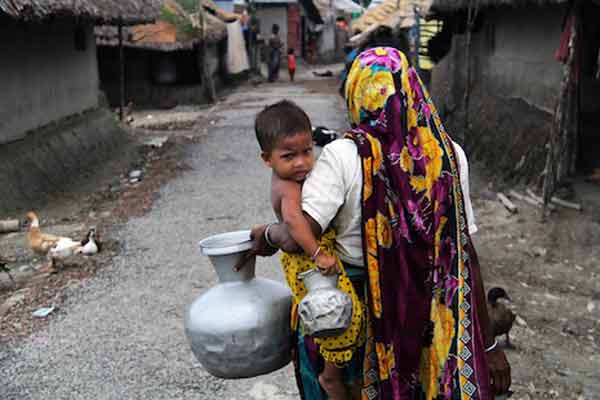
Satkhira, Bangladesh (BBN)-Since 2010, Seeta Rani Mohaldar and her husband have lived like refugees.
Her home now is a small, one-room structure with no electricity or running water.
Seeta treks kilometers into the forest to fish and collect firewood: she is her family's sole breadwinner, reports the UCA News.
“If I have a good catch, I can earn up to 250-300 Taka (US$3-4). We can manage meals for two days with that money,” Seeta said in a recent interview.
She is one of about 100 people living in a small village set up by Catholic charity Caritas to house local families displaced by 2009's devastating Cyclone Aila.
The storm left about 1 million people homeless in Bangladesh and India.
Here in Satkhira district in southern Bangladesh, it devastated Seeta’s family.
The nearby Boleswar River swallowed up her former home during the cyclone.
Her husband is bedridden and suffers from chronic diseases the family can’t afford to treat.
“We have no land, no jobs and no good income. Often, we don’t know if we will eat tomorrow or not,” Seeta said. "This is an unbearable life.”
Seeta's struggles are a common story here in the coastal of districts of Bangladesh.
Pope Francis's encyclical, Laudato si', articulated the dangers posed by climate change and implored the world to care for the environment.
Climate scientists believe the low-lying country is one of the world's most vulnerable to climate change.
Here in coastal Bangladesh, Seeta and the roughly 20 million people who live in the country's 16 coastal districts may be the human face of this risk.
GEOGRAPHY AND CLIMATE CHANGE
Bangladesh is located amid the world's largest river delta system and is crisscrossed by more than 300 rivers that empty into the Bay of Bengal.
Most of the country lies on flat land only a few meters above sea level.
Climate analysts fear that vast areas of Bangladesh coastline will vanish as sea levels rise- one of the commonly predicted consequences of a warming planet.
In a 2013 report, the World Bank said Bangladesh is among the 10 most vulnerable countries or “potential impact hotspots”, threatened by extreme river floods, intense tropical cyclones, rising sea levels and soaring temperatures.
“There might be various man-made reasons behind global warming and climate change, but the biggest of all is industrial pollution of the planet by rich, developed countries,” said Philip Gain, director of the Dhaka-based Society for Environment and Human Development.
“Sadly, poor people like coastal villagers in Bangladesh pay the price for it.”
The government has publicly recognized these risks. Over the years, it has improved the country's ability to respond to disasters, creating warning systems and cyclone shelters in vulnerable areas.
In 1970, for example, a massive cyclone hit what is now Bangladesh, killing 500,000 people.
In 1991, another cyclone ripped through the country's coast; 150,000 people died.
More recently, however, 2007's powerful Cyclone Sidr killed some 5,000 people.
Two years later, another cyclone killed about 300 people. In 2013, when cyclonic storm Mahasen fizzled past Bangladesh, hundreds of houses and tons of crops were destroyed, but no one was killed.
“Natural disasters are a top-priority agenda for the government,” said Reaz Ahmed, director general of the country's Disaster Management department.
He cited the construction of new cyclone and flood shelters in 13 key districts and the introduction of livelihood and rehabilitation programs for survivors.
According to the government, there are currently 4,000 cyclone shelter centers across the coastal region, with an additional 1,000 needed.
Caritas Bangladesh is among the nongovernmental organizations working on reducing risk from natural disasters.
Pintu William Gomes, senior manager for the group's disaster risk reduction program, said the government has improved its ability to respond to disasters. But there should be more work done to help future survivors get back on their feet.
“There is no doubt that Bangladesh has enhanced the capacity to tackle natural disasters, but there are fewer rehabilitation programs for affected and vulnerable people,” Gomes said.
Caritas programs cover 11 of the most vulnerable coastal districts.
They include housing programs — the kind that helped build Seeta Rani Mohaldar’s current home- livelihood schemes to help displaced farmers, and projects aimed at helping the most vulnerable adapt to the effects of climate change.
'CLOSER DAY BY DAY'
Sushil Kumar Mondol lives in the same village as Seeta. The 70-year-old is grateful for the help provided by Caritas, but the former fisherman says he is too weak to work, making it a daily struggle to feed his wife and himself.
“I have experienced many natural disasters in my life and people are used to it. Sadly, we are left to fend for ourselves and rebuild our lives once the disaster is over,” he said.
“We are stuck in an endless circle of disasters and suffering.”
Sushil, a Hindu, says the swelling Boleswar River claimed his house three times before Cyclone Aila.
When the storm finally destroyed his home for a fourth time, he had nowhere to go until Caritas stepped in.
“When I was a child, the river was far away, but it has come closer day by day,” Sushil said.
“If we lose our house in another storm or erosion, we don’t know where to go.”
BBN/SK/AD